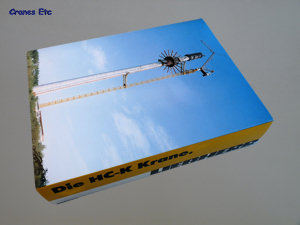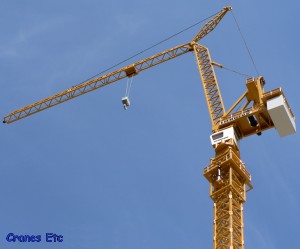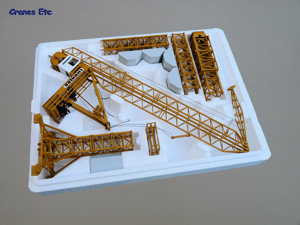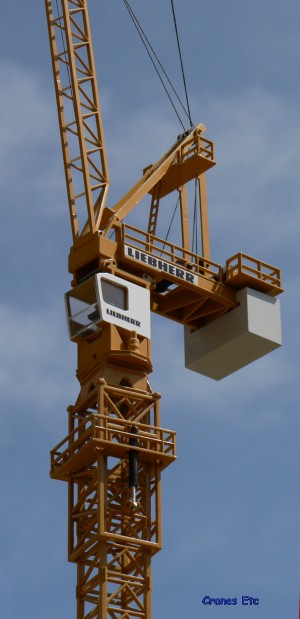 | | The box. |  |  | | It is an impressive model, but cries out for a better hook. |
| The Liebherr HC-K Tower Crane model has been available for a number of years. This review is of model number 2022 which has been updated in some minor ways and renumbered as model 2025.
Packaging
The box for this model is the usual Liebherr style sleeve with pictures binding together two expanded polystyrene trays. The review model was undamaged on arrival. Included is a useful instruction sheet explaining how the model fits together.
Detail
The base section is fitted with plastic bogies and has upstanding pins on to which the four solid base ballast blocks fit. The weight of this base arrangement steadies the whole model.
The mast sections join together by pushing together the sections which have tiny pins included. This system works well but it can be difficult to join the sections if they are not lined up properly. Mast detail is good although one section of the model actually comprises of four sections of the real mast. When joining the mast sections the orientation is important for realism as the lattice work differs on the various sides. The side with the sideways 'K' struts should be on the side of the hydraulic ram of the climbing frame (this is not mentioned in the instructions). There are no plastic ladders as in some other tower crane models of this scale. A capacity board clips on to the bottom of the mast.
The climbing frame is permanently attached to the cab section. Although the climbing frame looks alright, the walkways do not seem quite wide enough and the table for sliding in the mast section looks too high up the frame such that a scale mast section could not be slid in. The cab itself looks good including a seat for the driver and lacks only an internal structural element in the side windows.
The machinery platform and jib sections are permanently joined and the luffing mechanism is already wired up. Detail on the platform is basic with no electric equipment cabinets. The counterweight is a solid block which would have benefited from some grooving to give the appearance of a number of separate slabs, but it has good weight for stability. Jib sections are strong and well executed. Both trolleys are metal. The two jib pendants consist of pre-bent wire which works but replacing these with strings and tied hooks at each end is preferable and permits the model to be taken down and reassembled any number of times.
Features
The real crane is a relatively unusual model with its luffing arrangement. This works well on the model and the jib can be completely horizontal or have the inner section almost vertical. The hoist can also be operated with both the hoist and luffing arrangement controlled by Conrad's typical plastic winding handles.
Both trolleys can be slid along the jib. The secondary trolley should be parked at the top of the inner jib when the jib is luffed. The model rotates well and the counterweight position can be adjusted.
Quality
Casting, paintwork and lettering is all good. There is relatively little plastic used.
Price
The model is quite good value.
Overall
This crane looks good and can be posed in a variety of different heights and with the jib luffed or horizontal.
Footnotes
The model was introduced before 1993. Earlier versions had an all yellow cab which was changed to white in later versions. In 2004 model 2022 was updated and renumbered as model 2025. It has a modern cab design and interlocking jib pendants which are an improvement on the pre-bent wires of the older version. It does not further improve the model in the area of the climbing frame or by the provision of either mast ladders or a proper hook.
|
| |
|  | | The parts in the tray. |  | | The jib is not fully triangulated - the underside is 'hollow'. Ballast blocks would benefit from grooving to indicate separate slabs. |
|

